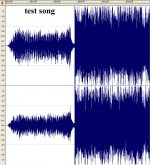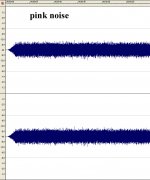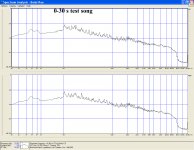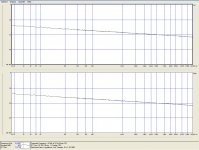How to burn a speaker at nominal power in 10 seconds
The speaker in question is a b&c 15cl76 B&C Speakers pompous ranked 800w continuous power program, but listed with 400w rms at minimum impedance in 6.3 ohm.
Pm1000-2 DYNACORD powermixer is used with a specified power of 350w to 700w 8 ohms and 4 ohms at 0.1% distortion (see page 84 in the link attached - http://www.dynacord.com/downloads/PowerMate2_Manual_Vs02.pdf ), equipped with limiter and high pass filter (search for dynacord lpn filter or consult page 26 in this link http://www.dynacord.com/downloads/Manual-PM3.pdf - with dynacord model 1000-2 is permanently activated at high settings.
Box used has a volume of 90-95 liters and is given to 48Hz with 300 cm² port. The manufacturer recommends 100 liters tuned to 47hz, somewhere very close to what was used.
The 10 seconds that has resisted "heroically" are from this song https://www.youtube.com/watch?v=6zfsIm6dRqE , right from the time they start bass.It is still a commercial song, not a subwoofer test song that contains sinusoidal.
Speaker manufacturer did not bother to respond to those few mails that exemplified this abnormal situation, in which a speaker died in 10 seconds at rated power without distortion on a commercial song. I mention that color of winding appears normal, not shaded (what is seen through ventilation holes), coil is not interrupted, but the adhesive gave up, making the speaker to be heard slowly and rub.
I want to know your opinion, if it was the incorrect operation, if this situation was normal to happen, or if it is a manufacturer poor quality.
The speaker in question is a b&c 15cl76 B&C Speakers pompous ranked 800w continuous power program, but listed with 400w rms at minimum impedance in 6.3 ohm.
Pm1000-2 DYNACORD powermixer is used with a specified power of 350w to 700w 8 ohms and 4 ohms at 0.1% distortion (see page 84 in the link attached - http://www.dynacord.com/downloads/PowerMate2_Manual_Vs02.pdf ), equipped with limiter and high pass filter (search for dynacord lpn filter or consult page 26 in this link http://www.dynacord.com/downloads/Manual-PM3.pdf - with dynacord model 1000-2 is permanently activated at high settings.
Box used has a volume of 90-95 liters and is given to 48Hz with 300 cm² port. The manufacturer recommends 100 liters tuned to 47hz, somewhere very close to what was used.
The 10 seconds that has resisted "heroically" are from this song https://www.youtube.com/watch?v=6zfsIm6dRqE , right from the time they start bass.It is still a commercial song, not a subwoofer test song that contains sinusoidal.
Speaker manufacturer did not bother to respond to those few mails that exemplified this abnormal situation, in which a speaker died in 10 seconds at rated power without distortion on a commercial song. I mention that color of winding appears normal, not shaded (what is seen through ventilation holes), coil is not interrupted, but the adhesive gave up, making the speaker to be heard slowly and rub.
I want to know your opinion, if it was the incorrect operation, if this situation was normal to happen, or if it is a manufacturer poor quality.
Last edited:
B&C are generally considered very good quality. But even like that there can be a manufacturing fault once in a while.
But with modern well ventilated drivers there is another problem that can arise: sometimes dirt and remains form cabinet manufacturing can make it into the air gap if one is not careful.
Are you sure that you cleaned your cabinets well on the inside afer manufacturing ?
Regards
Charles
BTW: Nice chicks in that video !
But with modern well ventilated drivers there is another problem that can arise: sometimes dirt and remains form cabinet manufacturing can make it into the air gap if one is not careful.
Are you sure that you cleaned your cabinets well on the inside afer manufacturing ?
Regards
Charles
BTW: Nice chicks in that video !
It is not about dirt or dust, I know this can happen. In my case, the glue that holds the coil windings bonded simply gave up, and I suspect turns are free and the bobbin is deformed.
If I would have used much higher power, I would have thought it was because of the thermal regime, but in 10 seconds I never thought it could give a speaker, even at twice the rated power and possibly distortion . It seems a clear case of low quality material.
I do not know why the manufacturer did not even cares to respond to emails sent. Is it true that once bought a loudspeaker there is no warranty for damage howsoever user is fault (unless the defect is in new condition)? Something like plug in or fell down the stairs?
If I would have used much higher power, I would have thought it was because of the thermal regime, but in 10 seconds I never thought it could give a speaker, even at twice the rated power and possibly distortion . It seems a clear case of low quality material.
I do not know why the manufacturer did not even cares to respond to emails sent. Is it true that once bought a loudspeaker there is no warranty for damage howsoever user is fault (unless the defect is in new condition)? Something like plug in or fell down the stairs?
Yesterday i burned in my 15" 18sound 42hz fs near xmech for 5-10minutes, loosened pretty much. Not much db's, one 15" in ob is not enough
I use B&C mids and tweeters and I find them to be good drivers.
..This has nothing to do with your problem but I almost melted the glue on the surround of one mid while casting a phase plug from epoxy. The glue set again and there seem to be no issues other than cosmetic.
..This has nothing to do with your problem but I almost melted the glue on the surround of one mid while casting a phase plug from epoxy. The glue set again and there seem to be no issues other than cosmetic.
I want to know your opinion, if it was the incorrect operation, if this
situation was normal to happen, or if it is a manufacturer poor quality.
I think you missed to spot this from the manufacturer:
Attachments
I stated from the beginning that I read data sheet. I know the power of 400 W is specified for 6.3 ohm impedance minimum, but that powermixer can provide 444w in the impedance at 0.1% distortion. Do not say anywhere that overcoming that power of 400 W to 6.3 ohms for 10 seconds, can lead to irreversible destruction of the speaker. And please note that I heard a commercial song, not sinusoidal.
I am no expert on this sort of power handling problem, but IIRC, the thing that destroys a voicecoil is heat, which depends on average power.
B&C quote 400W with 6dB crest pink noise long term.
That pans out as follows:
Average 100W
Programme 200W
Peak 400W (6db Crest Pink Noise)
Speaker power handling < Pro-Audio References
Seems to me that rap material might have been very energetic, and very compressed. 100W of heat is what the speaker can dissipate long term. About equivalent to a bright old filament lightbulb. Hope it helps.
B&C quote 400W with 6dB crest pink noise long term.
That pans out as follows:
Average 100W
Programme 200W
Peak 400W (6db Crest Pink Noise)
Speaker power handling < Pro-Audio References
3.b. (Scaled by me for your driver) Programme power. It is an archaic term that derives from old swept sinewave power tests. Nowadays, it does hold no real meaning. For most manufacturers, it is simply twice the average power, although other manufacturers may use ratios other than 2:1. It may be used as a guideline to the selection of amplifier power. For instance, a speaker with 100W average power and 200W programme power (2x100W) might use an amplifier with 200W output. This is for carefully controlled conditions; for more usual applications with some degree of abuse that amplifier would be too large.
Seems to me that rap material might have been very energetic, and very compressed. 100W of heat is what the speaker can dissipate long term. About equivalent to a bright old filament lightbulb. Hope it helps.
Last edited:
10sec wow short test > in a ported box the driver can be destroyed easily when cranked up all the way and the 1st bass note hits*. Investigate the high pass filter an go easy on high power program tests.
*the voice coil former is probably bent from contacting the back plate
sadly BC power rating is rated from Fs and up
most other OEMs will suggest an alignment AND a HPF corner freq and slope.
*the voice coil former is probably bent from contacting the back plate
sadly BC power rating is rated from Fs and up
most other OEMs will suggest an alignment AND a HPF corner freq and slope.
Last edited:
It seems the what B&C call "nominal" (6db Crest Pink noise) is what other people call peak! 🙁
This for AllenB's midrange:
http://bcspeakers.s3.amazonaws.com/2013/03/11/16/08/16/706/file
Adjusting that speaker reference I quoted earlier for the 15" driver:
All seems to make sense. A 450W amp is asking for trouble.
This for AllenB's midrange:
http://bcspeakers.s3.amazonaws.com/2013/03/11/16/08/16/706/file
Adjusting that speaker reference I quoted earlier for the 15" driver:
5. Selecting amplifier power
In general, the amplifier power needs to be larger than the speaker's rated power. This is because an amplifier only delivers its rated output power with sinewave signal, and delivers much less with a real signal with dynamics. As general guideline, it is recommended to use an amplifier delivering 50% more power than the speaker's average ("RMS") power. For example, for a speaker with 100W average power, an amplifier with an output of 150W may be used. If a small amplifier is used, sufficient level will not be reached, nor the perception that it is attained, so the signal will tend to be clipped to compensate, thus endangering the integrity of the speaker.
All seems to make sense. A 450W amp is asking for trouble.
400W at 43Hz (the low note in the linked song) is pushing that driver really close to it's rated Xmax. Therefore the power handling is probably already starting to diminish at that frequency.
If you read the fine print of the manufacturers datasheet they state that the continuous power is rated for pink noise Fs to 10*Fs. That signal will not generate anywhere near as much excursion as a continuous 43Hz bass note.
If you read the fine print of the manufacturers datasheet they state that the continuous power is rated for pink noise Fs to 10*Fs. That signal will not generate anywhere near as much excursion as a continuous 43Hz bass note.
The speaker in question is a b&c 15cl76 B&C Speakers pompous ranked 800w continuous power program, but listed with 400w rms at minimum impedance in 6.3 ohm...snip...
Bass excursion could be a factor, but the smoking gun here is surely that the RMS rating is actually 100W not 400W. 😀
Hey, I shouldn't be laughing. 😱
No PA speaker manufacturer is specifying drivers the way that you assume that it was done.
The driver in question should actually survive an average power of 400 Watts fed with a pink noise signal whose crest factor is 6 dB (noise doesn't have a constant amplitude).
But I wouldn't test a speaker with that much power for the first time either. Too large are the chances that something has been done wrong, (like wrong port calculation, cabinet joints not really airtight ....).
Regards
Charles
The driver in question should actually survive an average power of 400 Watts fed with a pink noise signal whose crest factor is 6 dB (noise doesn't have a constant amplitude).
But I wouldn't test a speaker with that much power for the first time either. Too large are the chances that something has been done wrong, (like wrong port calculation, cabinet joints not really airtight ....).
Regards
Charles
Last edited:
Let me correct that for you:
You do also have to filter the signal to avoid taking the driver outside its natural range. We do seem to be getting in a terrible muddle here... 🙄
No PA speaker manufacturer is specifying drivers the way that you assume that it was done.
The driver in question should actually survive a PEAK power of 400 Watts fed with a pink noise signal whose crest factor is 6 dB (noise doesn't have a constant amplitude).
But I wouldn't test a speaker with that much power for the first time either. Too large are the chances that something has been done wrong, (like wrong port calculation, cabinet joints not really airtight ....).
Regards
Charles
Speaker power handling < Pro-Audio References3.c. Peak power. Corresponds to the calculation of power based upon peak voltages. For a 6 dB crest factor signal, peak power is four times the average power.
You do also have to filter the signal to avoid taking the driver outside its natural range. We do seem to be getting in a terrible muddle here... 🙄
folks nothing got "burned" here
not in 10 seconds without fireworks, smoke and smells.
any good speaker box design program you can see excursion limits are massively lower than any thermal limits. you can hear it too, the driver will complain on those bass notes so either limit the lows or get off the volume knobs.
BC limits frequencies on thermal power Fs ~ 40-50 Hz > smack dab in band with most hip hop
not caring about distortion and simply matching amps rating to driver thermals is bad practice. without matched filters the question then becomes finding safe drivers with huge Xmech >> Xmax.
not in 10 seconds without fireworks, smoke and smells.
any good speaker box design program you can see excursion limits are massively lower than any thermal limits. you can hear it too, the driver will complain on those bass notes so either limit the lows or get off the volume knobs.
BC limits frequencies on thermal power Fs ~ 40-50 Hz > smack dab in band with most hip hop
not caring about distortion and simply matching amps rating to driver thermals is bad practice. without matched filters the question then becomes finding safe drivers with huge Xmech >> Xmax.
Last edited:
I blew one channel of my ( 30 W pc ) amp the other week, while powering for the 1st time my new speakers.
1) I was excited and couldn't wait the transistors to set on temperature
2) so i played the first song with the cdp at normal level, the second song at high level
3) one channel started to scream
I realized that i made some mistakes on the crossover
So, yes, new speakers might also get hot ( if the construction permits > good thermal exchange between VC and basket ) during burn-in .
sorry this is OT
1) I was excited and couldn't wait the transistors to set on temperature
2) so i played the first song with the cdp at normal level, the second song at high level
3) one channel started to scream
I realized that i made some mistakes on the crossover

So, yes, new speakers might also get hot ( if the construction permits > good thermal exchange between VC and basket ) during burn-in .
sorry this is OT
nice story pico
amps don't like miswired crossovers, as we say in gaming chat "cool story bro"
amps don't like miswired crossovers, as we say in gaming chat "cool story bro"
Last edited:
Test song vs. pink noise
I have downloaded the test song OP used and did the spectrum analysis.
Are these equivalently loading the speakers? For the first 30 sec.
For the first 30 sec.
I have downloaded the test song OP used and did the spectrum analysis.
Are these equivalently loading the speakers?
 For the first 30 sec.
For the first 30 sec.Attachments
- Status
- Not open for further replies.
- Home
- Loudspeakers
- Multi-Way
- How to burn an b&c speaker at nominal power in 10 seconds






